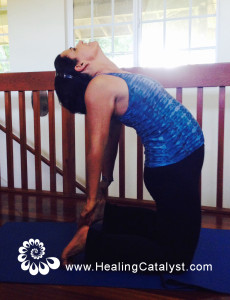 Understanding emotional release in Yoga class – tips for instructors
Understanding emotional release in Yoga class – tips for instructors
If you are a yoga instructor or have practiced yoga for any length of time, you have witnessed both tears and laughter as people move and stretch through the postures. The deeper you get into a practice, the greater the chance you have experienced emotional releases yourself. The first time it happens can be startling, but over time you learn to breathe into it and allow the tears to flow. But how do you help others with this experience? Everyone has unexpressed emotion and yoga (or tai chi, or qi gong) can provide the catalyst and the opportunity to release it. Your skill in handling an emotional opening can turn a routine class into an opportunity for deep healing. Whether you want to expand your ability to facilitate emotional release in yoga class or simply want to understand more fully what’s going on for yourself, here are some things to consider.
When the tears start to flow
Every person is a complex and fascinating composite of physical, mental, emotional and spiritual energy all blending to form a whole. We can’t pinpoint where emotional leaves off to become physical or where mental becomes spiritual and we don’t need to. Recognizing that we all have emotional energy trapped in our bodies and that releasing it is normal, natural and healthy is an important starting point.
In additional to the stresses of daily life, a person may be in a relationship crises, grieving the death of a loved one, worried about a sick parent or addicted teenager, juggling financial worries… If she[1] runs from one demand on her time and energy to another without taking adequate time to rest and process emotion, the energy and stress accumulate.
Stress layered over stored emotions
Underlying the day-to-day stress is all the emotion that got stifled as we grew up. Learning not to express what we’re feeling – not to hit when angry or cry when sad – is part of socialization. Girls are typically discouraged from expressing angry or powerful emotions. Boys are often ridiculed if they cry or show emotion that appears “weak”. We quickly learn to suppress the emotions that are not socially acceptable. Then there’s all that stuffed-down pain from being unseen or badly treated. Our mothers tell us – in subtle and not-so-subtle ways – that we’re not beautiful or our fathers say we’re not good enough. Many of us have been abused.
We accumulate layer after layer of sadness, fear, anger – even joy – that couldn’t be expressed by stuffing down the energy with held or limited breath. We naturally and unconsciously hold our breath when we’re scared or don’t want to feel something. Early on, we learned to suck in our bellies in order not to look “fat” or we clenched it to “gut through” fear. Those two patterns compound to create a habit of holding in our bellies, breathing minimally, and not feeling much. This also cuts off our access to our intuitive wisdom as the rational mind takes over and we live in our heads.
Interrupt the mental hamster wheel
Fortunately we can interrupt this loop by allowing the belly to expand, opening the breathing and allowing emotional energy to flow on through. It is a huge relief when long-held emotions finally get to move on through and out.

Poses that open the chest, hips and shoulders are especially apt to trigger emotional release. The camel pose and wheel pose are known tear-jerkers. Even the quiet child’s pose can elicit emotional release if you need it and are feeling safe to do it.
Breathing is the key. It serves as the transport vehicle out of the head and into the body, where the emotional energy is stored, waiting for release.
Breath is also the access point for the intuitive wisdom we all have. And in a yoga practice that aims to open the breathing, emotions are eventually going to come up. Whether you are teaching a yoga class, doing asanas on your own, or doing another meditative practice, the thing to do when emotions arise is to deepen the breath and sink into them even further.
If you are the instructor, you hold space for another by deepening your breath and encouraging them to do the same. That’s how you re-gain access to your intuitive strength. That’s how you can meet unwanted emotions that have been stuffed down for processing “later” with grace. When emotions overflow in a practice, that “later” has become now.
Give Present Moment Attention
You can give yourself or your students an amazing gift simply by understanding this and surrendering to what’s happening in the moment. You don’t need a degree in psychology or to be a high-level intuitive to facilitate this healing. It only takes a willingness to take a breath, go within, and hold space for potentially uncomfortable emotions. The more you practice this, the more you will gain confidence in your intuitive ability. You can tell you are in that open, intuitive space if you feel loving, warm and clear. Thoughts and impulses seem to come from somewhere other than your mind. Time stops; and you feel connected up and out of your own personality. It can feel like plugging into an electrical current.
The idea is to bring a child-like wonder and curiosity to the moment. Let go of your pre-conceived ideas, agenda and judgment. Let the body that is releasing emotions lead the way. If you don’t understand something you feel, ask directly. It is amazing how willing most bodies are to “speak” when given a sincere and willing ear. You create the opening with an attitude of allowing far more than with any particular technique. Adding your breath, and intuitive insight to the knowledge and experience you already have will expand the healing possibilities of your practice immensely.
To bring all this into a yoga class it will help to remember the following points:
How to hold space for Emotional Release in yoga class – 8 tips
- 1. Deepen the Breath. If your student is clenching her breath, remind her to breathe. She may be consciously clenching her muscles and holding the breath to suppress scary or overwhelming emotion or it could be an old, unconscious habit. Remember that it’s just energy that’s moving. Sometimes the expanded breathing lets the emotion move through without much drama. If the drama and energy increase, that’s your cue to increase the breath – in everyone involved. Like a wave it will eventually run its course.
- 2. Make sure you are breathing fully. Take a deep breath yourself and relax. If you are worried about her emotions, she will be, too. As you breathe, you will relax and she will naturally begin to open her breathing to entrain with yours. As you slow down and connect within, so will your client. Have her deepen her breath. This will help her release the stuck energy. All you have to do is hold the space, breathe and open yourself.
- 3. Ask your intuition “what would be best here?” You can even quietly ask the student what her body is trying to say. It is amazing how willing most bodies are to “speak” when given a sincere audience. You can say something like, “If your shoulder could speak, what would it say?” The opening comes more from an attitude of allowing than any particular doing. If you understand that emotional energy is part of a person and that it simply needs safe place to release you will more easily get out of the way and facilitate the process.
Deepen
- 4. Deepen your attitude of acceptance and allowing. That way you create a space for your student’s feelings and she/he can let down her/his defenses. Suspend your judgment as much as you can and simply see her as a person, possibly in pain, and definitely in need of comfort. Whatever she’s working through is her business. You don’t have to have the answer for her or solve the problem – in fact, it’s better if you don’t. Your biggest gift is to be a non-judgmental witness. A student may want to release the emotional burdens she carries but not feel that it’s safe or socially acceptable to go into anything deep in a class. Your acceptance will allow her to meet the layers of emotions tangled within and also allow the others in the room to support and hold space too. Because we are empathic beings, one student’s release can trigger feelings in the others, as well. She will find her own resolution if given the space to do so. If you feel soft and compassionate, she will sense it and relax.
- 5. Offer support and encouragement. This can be in the form of a gentle hand placed on a shoulder or back. You can silently make eye contact to ask if what you are offering is ok with her. You can bring a box of tissue close enough to reach but without insisting she clean up her tears. Your acceptance creates an opening for her to deepen into the wave of energy so it can release completely. As you practice, you will gain confidence in your ability to intuit what’s going on and respond appropriately.

Offer Your Calm Presence
- 6. Always go back to the breathing. Whatever she is feeling – it’s simply energy, even if it’s intense, and breath is the vehicle for it to move and release. You can easily see and feel when she is holding her breath or breathing shallowly. If you see your client is breathing fast or shallowly, that’s a sign she’s unconsciously working to hold down emotional energy that’s trying to surface. Encourage her to breathe. Be patient. It will pass.
- 7. Trust that what is meant to happen, will. While everyone has emotional energy that might need to be released, not everyone is willing or ready. And your class may not be the right place to release it. Don’t push but simply offer the opportunity and wait to see what happens. So many times I stayed present, followed my intuition and then thought nothing particular happened. Later, my client would say, “That was exactly what I needed.”
- 8. Help your student come to closure well before the end of the session or class. If you notice you are nearing the end of the class, and your student still has emotions pouring out, don’t be afraid to explain the limits of your setting. You can offer the possibility of staying after class with her. If that’s not an option, ask, “What can we do to bring this to a safe and satisfying conclusion?” Often simply acknowledging that she isn’t finished and that you want to accommodate her process is a healing. She might not know exactly what she needs, but discussing it is better than ignoring it or abruptly cutting her off.
Emotional Exchange
It is beautiful when you can create a space where a student feels safe enough to let down her defenses and release some tears. She’s giving you the gift of openness and vulnerability. You’re giving her the gift of loving attention.
Remember to come back into your body with your breath and get out of the way. Your understanding of the emotional release process and attitude of acceptance becomes a healing gift to your clients and will take your work to a whole new level.
You can explore this website for more exploration of the emotional energy stuck in the tissues or read more about facilitating emotional release in my book Issues in your Tissues.
#yoga #qigong #emotionalrelease #taichi #emotionsinyoga #healingenergy #professionaldevelopment
More resources for healing professionals: MauiHealer.com


